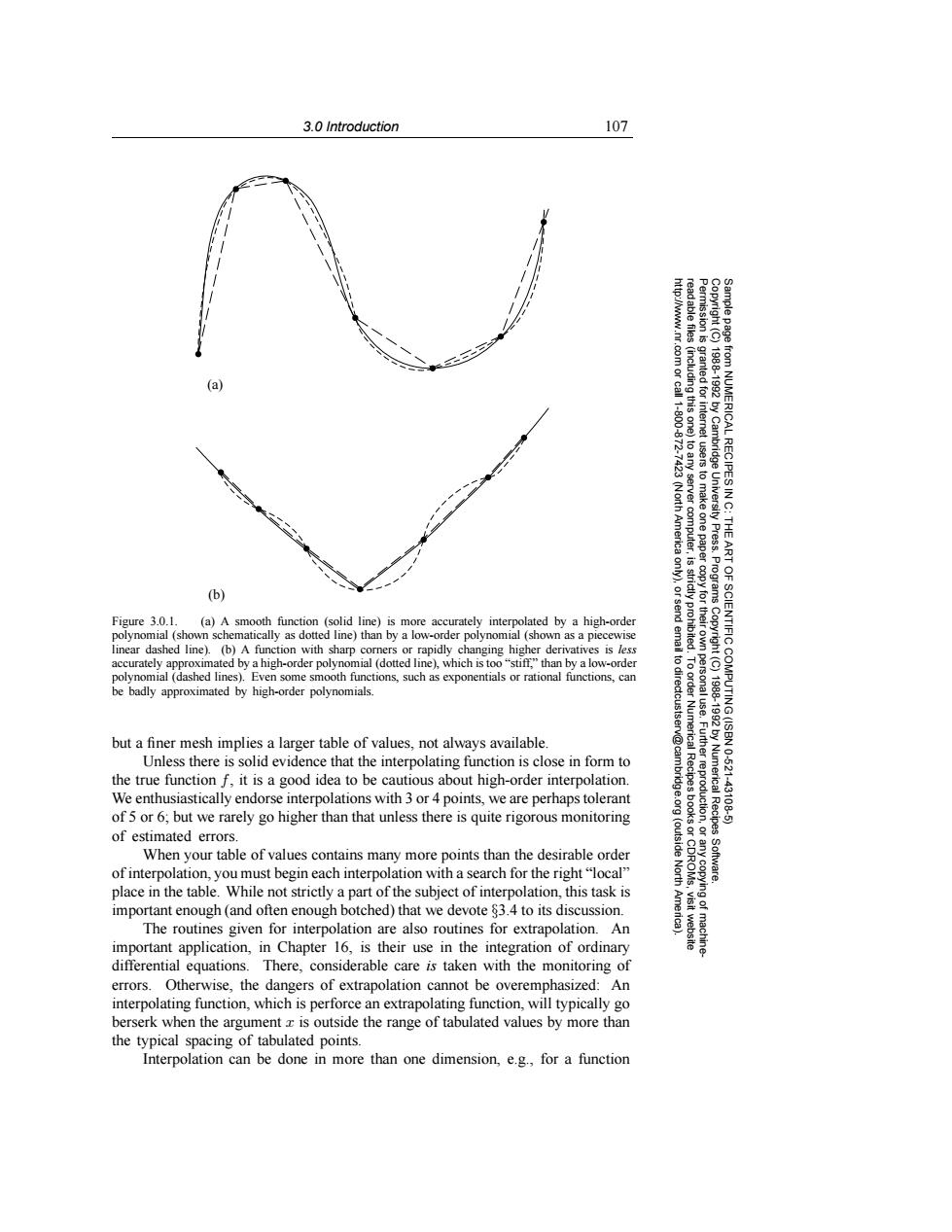正在加载图片...

3.0 Introduction 107 http://www.nr. read able files .com or call granted for 19881992 11-800-872 (including this one) to any /Cambridge →423 74 uae us e University Press. n NUMERICAL RECIPES IN C: server computer, THE 是 (b) strictly proh Programs Figure 3.0.1. (a)A smooth function (solid line)is more accurately interpolated by a high-order polynomial (shown schematically as dotted line)than by a low-order polynomial (shown as a piecewise linear dashed line).(b)A function with sharp corners or rapidly changing higher derivatives is less accurately approximated by a high-order polynomial (dotted line),which is too "stiff,"than by a low-order polynomial (dashed lines).Even some smooth functions,such as exponentials or rational functions,can to dir be badly approximated by high-order polynomials. 1881892 ART OF SCIENTIFIC COMPUTING(ISBN but a finer mesh implies a larger table of values,not always available. Unless there is solid evidence that the interpolating function is close in form to Numerical 10-621 the true function f,it is a good idea to be cautious about high-order interpolation. We enthusiastically endorse interpolations with 3 or 4 points,we are perhaps tolerant .Further reproduction, Recipes 43108 of 5 or 6:but we rarely go higher than that unless there is quite rigorous monitoring of estimated errors. When your table of values contains many more points than the desirable order (outside of interpolation,you must begin each interpolation with a search for the right"local" 首 Software. place in the table.While not strictly a part of the subject of interpolation,this task is important enough(and often enough botched)that we devote 83.4 to its discussion The routines given for interpolation are also routines for extrapolation.An visit website important application,in Chapter 16,is their use in the integration of ordinary machine differential equations.There,considerable care is taken with the monitoring of errors. Otherwise,the dangers of extrapolation cannot be overemphasized:An interpolating function,which is perforce an extrapolating function,will typically go berserk when the argument z is outside the range of tabulated values by more than the typical spacing of tabulated points. Interpolation can be done in more than one dimension,e.g.,for a function3.0 Introduction 107 Permission is granted for internet users to make one paper copy for their own personal use. Further reproduction, or any copyin Copyright (C) 1988-1992 by Cambridge University Press. Programs Copyright (C) 1988-1992 by Numerical Recipes Software. Sample page from NUMERICAL RECIPES IN C: THE ART OF SCIENTIFIC COMPUTING (ISBN 0-521-43108-5) g of machinereadable files (including this one) to any server computer, is strictly prohibited. To order Numerical Recipes books or CDROMs, visit website http://www.nr.com or call 1-800-872-7423 (North America only), or send email to directcustserv@cambridge.org (outside North America). (a) (b) Figure 3.0.1. (a) A smooth function (solid line) is more accurately interpolated by a high-order polynomial (shown schematically as dotted line) than by a low-order polynomial (shown as a piecewise linear dashed line). (b) A function with sharp corners or rapidly changing higher derivatives is less accurately approximated by a high-order polynomial (dotted line), which is too “stiff,” than by a low-order polynomial (dashed lines). Even some smooth functions, such as exponentials or rational functions, can be badly approximated by high-order polynomials. but a finer mesh implies a larger table of values, not always available. Unless there is solid evidence that the interpolating function is close in form to the true function f, it is a good idea to be cautious about high-order interpolation. We enthusiastically endorse interpolations with 3 or 4 points, we are perhaps tolerant of 5 or 6; but we rarely go higher than that unless there is quite rigorous monitoring of estimated errors. When your table of values contains many more points than the desirable order of interpolation, you must begin each interpolation with a search for the right “local” place in the table. While not strictly a part of the subject of interpolation, this task is important enough (and often enough botched) that we devote §3.4 to its discussion. The routines given for interpolation are also routines for extrapolation. An important application, in Chapter 16, is their use in the integration of ordinary differential equations. There, considerable care is taken with the monitoring of errors. Otherwise, the dangers of extrapolation cannot be overemphasized: An interpolating function, which is perforce an extrapolating function, will typically go berserk when the argument x is outside the range of tabulated values by more than the typical spacing of tabulated points. Interpolation can be done in more than one dimension, e.g., for a function